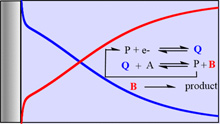Publication
851
ACS Catal., 8, 5286-5297, 2018
DOI:10.1021/acscatal.8b01195
|
|
|
|
|
|

|
Homogeneous Catalysis of Electrochemical Reactions: The Steady-State and Nonsteady-State Statuses of Intermediates
|
|
|
|
Cyrille Costentin and Jean-Michel Savéant
Sorbonne Paris Cité, Laboratoire d’Electrochimie Moléculaire, Unité Mixte de Recherche Université - CNRS N° 7591, Bâtiment Lavoisier, Université Paris Diderot, 15 rue Jean de Baïf, 75205 Paris Cedex 13, France
In the context of modern energy challenges, there is an increasing need to decipher the mechanism of complex, multistep catalytic processes, as a basis of their optimization and improvement. Cyclic voltammetry (CV) is one of the most popular electrochemical techniques in this purpose. Mechanistic complexities often trigger a quest for simplification in the treatment of data, such as the application of the steady-state approximation to intermediates. The validity of such assumptions actually needs justification. This is the object of the present work, which examines the question for five homogeneous catalytic reaction schemes of practical interest, which can also serve as tutorial examples for the analysis of further schemes. The analysis is simplified by the consideration of pure kinetic conditions and constancy of substrate concentration. These conditions can be achieved, in practice, by appropriate manipulation of the scan rate and concentrations. The current–potential responses are consequently S-shaped and independent of the scan rate. The CV responses are then dependent upon only two dimensionless parameters that group the experimental intrinsic and operational parameters. Limiting the subcases reached for the extreme values of these parameters is worth considering in terms of mechanism diagnosis and kinetic characterization. They are conveniently represented by kinetic zone diagrams. The present work not only provides the tools required to check the correctness of the kinetic analysis but also to gauge the possibility of characterizing transient intermediates by structurally informative techniques (e.g., spectroscopic). |

